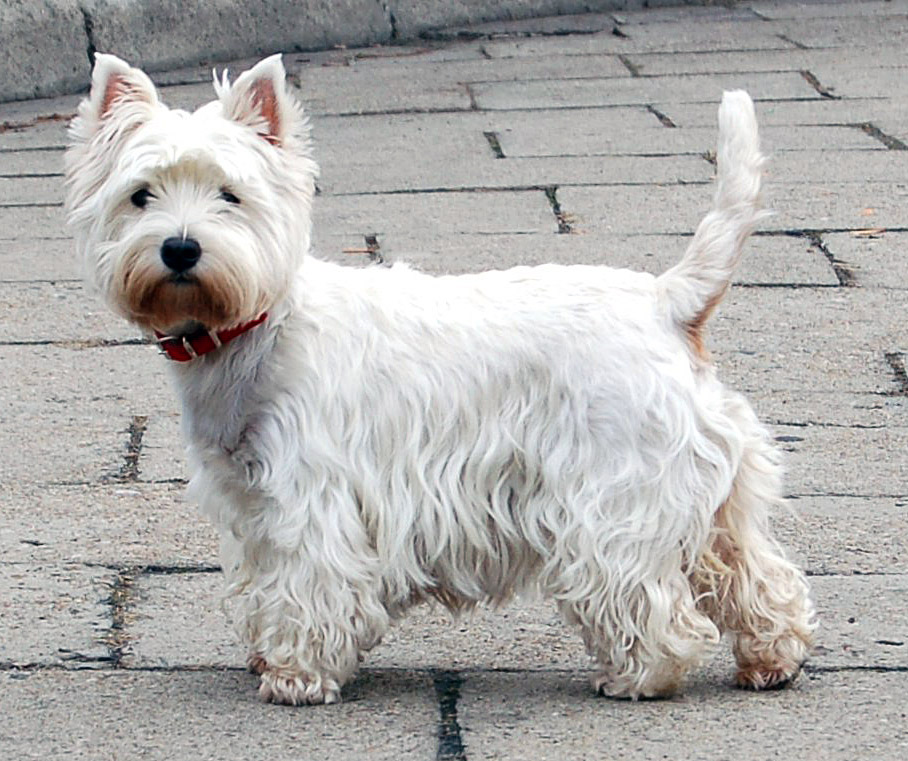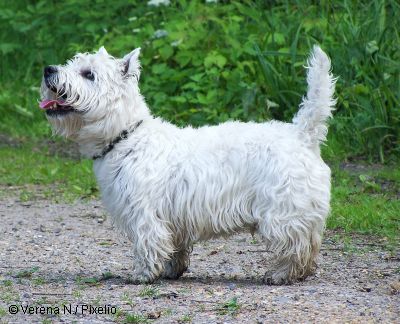 Known to many people as the "Westie," this breed is a small dog but is very well balanced and hardy. Always able to exhibit good showmanship when exhibited, especially when they are groomed properly, they are very elegant looking with a beautiful white coat and bright dark button eyes. For a more detailed look, the head has a round appearance from the front view, with dark and almond shaped eyes with black rims. Erect and small ear end in sharp points, while the muzzle is blunt tipped with powerful jaws, tapering toward the nose area. The teeth appear to be too big for the small dog, with six incisor teeth between the canines of the upper and lower jaw.
Known to many people as the "Westie," this breed is a small dog but is very well balanced and hardy. Always able to exhibit good showmanship when exhibited, especially when they are groomed properly, they are very elegant looking with a beautiful white coat and bright dark button eyes. For a more detailed look, the head has a round appearance from the front view, with dark and almond shaped eyes with black rims. Erect and small ear end in sharp points, while the muzzle is blunt tipped with powerful jaws, tapering toward the nose area. The teeth appear to be too big for the small dog, with six incisor teeth between the canines of the upper and lower jaw. |
| THESE ARE WEST HIGHLAND WHITE TERRIER PUPS. |
With a double coat, the Westie is strongly built, while deep in the chest and back ribs. The back is straight and the hindquarters are powerful with very highly muscular legs. When exhibiting in shows, the breed demonstrates great strength and energy levels. Its gait is free and easy, while showing a distinctive drive that is powerful to see. Its legs see to not move in a square when viewed from the front, while the hind movement is free and strong.The wiry coat of the little Westie needs brushed about three times a week, or more depending on the lifestyle, with shaping and stripping once every three months. If the West Highland White Terrier is to be shown at a dog show, shaping will be done by stripping, while clipping does the job adequately as pets. The coat of the Westie is a harsh double coat, and was originally developed to provide protection when hunting. The tail with full hair was necessary to pull the dog backwards out of shallow holes when it was digging and hunting varmints.
 |
| THEY LOOK REALLY ADORABLE |
Originating in the highlands of Scotland, many breeds have the West Highland White Terrier blood line in them, all originating back to the early 1800's with each breed deriving their name from the areas of their origin. These short-legged Scotland terriers are now known as the Scottish, Skye, Cairn, DandieDinmont, and West Highland White Terriers--and all were bred as small game hunters. Not raised as pets alone, each breed of terrier was a working dog and had a specific purpose-keeping vermin in control for the Scotland villages, coalmines, mills, farms, and homes. Zestful diggers and hunters as they were, flower gardens and vegetable patches today presents a challenge to these little hunters.
 |
| HE SEEMS TO BE INVESTIGATING SOMETHING |
The Westie is a very intelligent dog who loves human companionship both indoors and outdoors-but do have issues with other pets or small animals. Introduce them gradually to the little newcomers, making sure the Westie is not ignored or pushed back. Happy, curious, and always trying to get into the middle of everything, they are considered one of the most affectionate of all the terriers with their also demanding personality-yet can still feel jealousy if their homeland is threatened.
 |
| A MOTHER DOG WITH ITS CUTE LITTLE PUPS. |
They are very popular due to their extreme versatility. And like most terriers, this breed loves to bark and dig-or dig and bark-anyway, they have a tendency to do both at the same time, while showing off their independence and stubborn attitude. A high energy level requires walks in the park, leash-training lessons, fetching balls or toys, or sleeping. Due to a high need to stay active when awake, sleeping about 13 hours a day is required by the little Westie when they finally collapse. In fact, many Westie owners say that if their West Highland White Terrier is contented, they can sleep as much as 22 hours a day! But when they are awake, watch out for a pure energy ball of business.
 |
| THIS IS A PAINTING OF TWO TERRIES OF THAT PARTICULAR BREED. |
The West Highland White Terrier has a few major ones are globoid cell leukodystrophy, along with Legg Perthes disease and CMO. The Globoid Cell Leukodystrophy disease is similar to Krabbe's disease in people. A storage disease, it is an accumulation of galactocerebroside, which is a component of myelin, leading to a progressive loss of the myelin. The breeds that are most affected by the disease are the Cairn and the Westie through an autosomal recessive disorder. Sporadically, the disease has been reported in the Beagle, Miniature Poodle, Basset Hound, Pomeranian, and blue tickhound. Minor concerns are copper toxicosis, Cataracts, patellar luxation, Deafness, with suggested testing areas as the hip and knee.
 |
| THIS LOOKS A BIT FUNNY..! |
The Westie should be trained to be accustomed to any grooming features as a young puppy before grooming ever begins, beginning with two to three minutes a day to begin with. Daily combings will make him accustomed to being touch all over, and the pleasure of having his coat brushed. The West Highland White Terrier needs firmness when this early training begins, but no roughness or loud voices should be part of the training methods. The next step is to begin the habit of grooming the little Westie about once a week to clip out of place hair and checking his ears, gradually increasing the time spent on the actual grooming. A two to three minute brush-out should begin to be done on a daily basis, laying the Westie puppy on the grooming table until the young dog begins to be anxious about the grooming. The decision whether to strip or groom the little Westie depends a lot on whether or not the dog will be shown or not. Simply put, it is a matter of personal preferences, as stripping makes the coat harder and coarser, while clipping the coat makes it softer and wavy on some dogs.
Most people clip a dog because it is easy and quick, and both methods give two entirely different looks to the breed. If the groomers or the owner is good at dog grooming, the standard look of the breed will be as good with a clipper as with stripping. If the decision to use clippers gives too soft of a look, changing the mind is still an option as once the hair is grown back slightly, hand stripping can be done then until it gets the real Westie
look and feel, done naturally.| AWWWWWW |
The Westie, as a high-energy dog, can develop pent-up energy when sitting around the apartment all day waiting for the family to come home. If the West Highland White Terrier does not get enough exercise to remove this energy, or at least spread it around a bit, then destructive behavior can occur. This behavior can occur in many forms-chewing, barking, digging, stubbornness, not minding, vomiting, stool issues, and depression.
| LOOK AT ITS EYES |
 |
| A WEST HIGHLAND TERRIER. |
Some commands are more important than others-at least to begin with. The West Highland should know the five basic commands plus some-come, heel, sit, down, and stay. Combining them to form a sit-stay and down-stay is also very beneficial for a dog such as the Westie with an overwhelming attraction to people combined with high energy
. Stay firm yet positive, always ending every training session with a command the dog does know, even after spending an hour or so learning new ones.
check out my website whoeveryouare
ReplyDeletefuronlyanimalpeople.blogspot.com